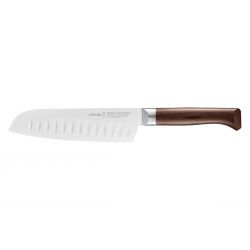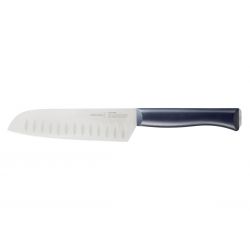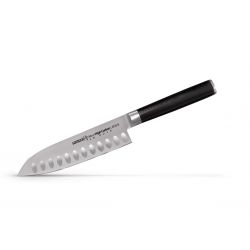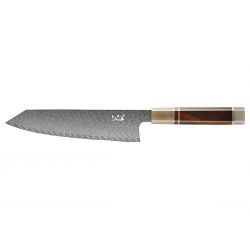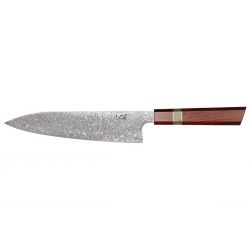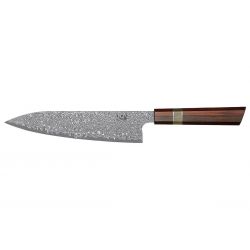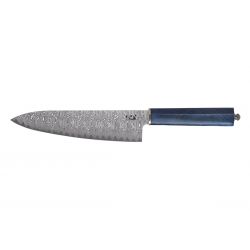Why buy Japanese knives?
For several years, Japanese knives have been proving to be a tool with reliable and functional characteristics. But why so successful? The aspects that have certainly contributed to the fame and spread of Asian knives in the Western world are different.
One of the most interesting, must certainly be sought in the shape of the blades. In fact, traditional Japanese knives are characterized not only by their typical shapes, but also by less evident characteristics, such as the angle of the wire, the type of steel used for forging, or the presence or absence of the protective neck at the end of the blade (which is absent in traditional models).
Characteristics of Japanese Knives:
If you are unfamiliar with this sector, you should know that Japanese knives have their own characteristics that differentiate them from Western models in general. In fact, these are different for the shape, but also for the type of materials used and finally also for the names that distinguish them. In fact, in the Japanese world the names of knives are not linked to a function, but are unique proper names with their own meaning.
.jpg)
1) The Shape;
Although today we are used to seeing and knowing many of the more classic shapes used in Japanese knives, these have only been spread in the West in recent years. Extremely famous solutions today, such as the Santoku knife, were unknown until a few years ago. The shape of the Japanese knife has contributed to its diffusion, not only for an aesthetic factor clearly, the shape of these blades coming from the oriental culture, are the result of a careful search for minimalist perfection. In fact, according to Asian culture, a knife with good characteristics is a multifunctional knife suitable for performing multiple functions. Santoku, for example, is known as the knife of the three virtues, as it is considered the perfect tool for cutting meat, fish or vegetables.
In addition to the santoku, for example, we remember the Deba knife, which can be used as a small kitchen cleaver, but at the same time also perfect for filleting thanks to its thinner blade at the tip.
Greater functionality in a single blade therefore made it easier to spread these kitchen knives that have had the opportunity to make themselves known in the world.
2) Matrials;
The typical technical characteristics present in traditional Japanese knives also contributed a lot to their diffusion. The use of high-grade steels such as Aus 10 steel and other well-known ones certainly contributed. Also features such as the type of sharpening, which in traditional models can only be done on the side of the cut and therefore asymmetrically or the angle of sharpening.
3) Names;
As anticipated, every Japanese kitchen knife has its own unique name that distinguishes it from the others. These therefore differ not only in their shape, but also in their different names. The best known name is clearly Santoku. This specifically means "three virtues", the reason for this name is to be found in the fact that this knife is considered the ideal tool for cutting the hulls, fish or vegetables.
The name Yanagiba instead in Japanese means "willow leaf". The knife bears this name, clearly home to its singular shape designed for filleting. Similarly Nakiri means "vegetable mincer" and so on.
Japanese Knife Set;
Another important aspect that we point out concerns the Japanese knife sets. Unlike traditional knife sets of Western origin, these are characterized by offering multifunctional knives. The reasons for the success that characterized the shape of the Japanese knife can also be found in the knife sets. In fact, a Japanese knife can be used for multiple functions, so a set of Asian knives can be considered equivalent to a set consisting of several pieces or a chef's briefcase.
Best handcrafted Japanese knives;
If you are passionate about this sector, you are probably looking for the best handcrafted Japanese knives. On this page to answer your curiosity, we have selected some successful brands, which for years have been making handmade knives made in Japan. Specifically, if you are looking for an artisan product, we recommend that you evaluate the products of the Spyderco brand.
This company, famous in the outdoor world, has been collaborating for years with the most renowned Japanese artisans for the production of its own made in Japan kitchen products. Among the best known forms we remember the Bunka, but also the Wakiita Gyuto line.
In Conclusion;
Looking at the world of Japanese knives, we were able to highlight some of the aspects that have contributed to the success of these products over the years. Starting from the different blade shapes, we talked about how each Japanese knife is designed to perform more functionality. For example the Santoku, which was born as a blade designed to cut meat, fish or vegetables or the Deba knife, known as the small Japanese cleaver, also ideal for filleting.
On this page on Knife Park you will find many of the best known shapes in use in Japanese culture and beyond. different lines of kitchen knives made with excellent materials, select to offer you the best.



































































